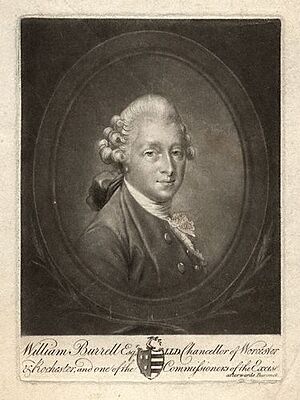Sir William Burrell, 2nd Baronet facts for kids
Sir William Burrell (born October 10, 1732 – died January 20, 1796) was an English antiquarian. An antiquarian is someone who studies old things like historical objects, places, and records. Sir William was very interested in history and spent much of his life studying the past.
Contents
Early Life and Education
William Burrell was born in London on October 10, 1732. He was the third son of Peter Burrell. William went to St. John's College, Cambridge, a famous university. He studied law there and became a lawyer.
After finishing his studies, he worked as a lawyer, mainly dealing with cases about ships and the sea. He even wrote down notes from many of the cases he worked on.
Public Life and Family
William Burrell held several important jobs. He was a member of Parliament, which is like being a representative in the government. He was elected for a place called Haslemere in 1768. He also worked as a commissioner for excise, which means he helped collect taxes.
He was a member of the Royal Society, a group for important scientists, and the Society of Antiquaries of London, a group for people who study history.
In 1773, William married his cousin, Sophia Burrell. Sophia was a talented writer and poet. Her father, Sir Charles Raymond, was a wealthy man. When Sir Charles passed away, William inherited his title and became the 2nd Baronet. This meant he became "Sir William Burrell."
Studying History: His Passion
Sir William Burrell loved history, especially the history of Sussex, a county in England. He spent many years exploring almost every town and village in Sussex. He visited churches, old houses, and monuments.
He carefully copied old records and had drawings made of historical buildings. He also researched the family histories of people who lived in Sussex. He wanted to learn everything he could about the county's past.
Even though he collected a huge amount of information, he never published any books himself. Instead, he gave his entire collection of notes, drawings, and records to the British Museum. This collection is still there today and is very important for historians.
Sir William's interest in history wasn't just limited to England. In 1758, he traveled widely in Scotland. At that time, not many people traveled for fun, so his journals about Scotland are a valuable source of information about what life was like there long ago.
Later Years and Legacy
In 1787, Sir William Burrell became ill and had to stop working. He moved to a place called Deepdene in Surrey with his wife, Sophia. He passed away on January 20, 1796.
He was buried in West Grinstead, Sussex. A simple monument made by a famous artist named John Flaxman was placed in the church to remember him.
Sir William Burrell is remembered as a dedicated antiquarian who helped preserve a lot of history, especially for the county of Sussex. His collection at the British Museum continues to be a valuable resource for people studying the past.


